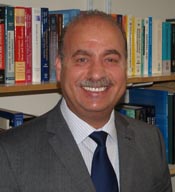Please note, this page has been archived and is no longer being updated.
A vital advanced water treatment membrane made of electrically conductive nanofibers which is self-cleaning is the brainchild of eminent Chemical Engineering Professor Nidal Hilal, Director of the Centre for Advanced Technologies and Environmental Research (CWATER) at Swansea University’s College of Engineering.

Self-cleaning membranes offer a critically needed solution to the problem of the unwanted build-up of organic and inorganic deposits on a membrane’s surface that reduces the membrane’s ability to filter impurities. Water treatment and purification membranes that can easily clean themselves when fouled could make pressure-driven membrane filtration systems used to treat and desalinate water more energy-efficient.
Keeping membranes clean, permeable and functional is a great challenge to membrane desalination technologies. When a membrane becomes fouled much less water can pass through the membrane at a constant pressure.
Conventional methods for cleaning fouled membranes involve expensive and harsh chemical treatments, and often lead to water treatment plant shut-downs, which can cost millions of dollars in lost operational hours. In the UAE, annual spending on desalination is already estimated to cost 3.5 US$ billion, indicating a pressing need for solutions that avoid costly shut-downs and treatments.

In addition to posing a heavy financial burden, fouled membranes are also a sustainability issue, as once a membrane becomes fouled, the higher pressure needed to push water through clogged pores significantly increases the plant’s energy consumption. The harsh chemicals used to clean a fouled membrane are also bad for the environment and require neutralizing. Thus, finding a way to easily and quickly clean fouled membranes not only makes financial sense, but environmental sense.
In a country like the UAE, where natural gas-powered thermal desalination produces over 80% of the country’s domestic water, innovative technologies like self-cleaning membranes to support a shift toward lower-energy and lower-cost membrane-based desalination are essential for achieving economic and environmental balance while meeting the UAE’s water demands.
And a research group from Masdar Institute with Professor Hilal may have brought the UAE closer towards realizing a more sustainable and economic approach to membrane desalination through their research on the application of advanced nanofibers for enhanced, self-cleaning membranes.
Professor Hilal was been heavily involved in this research from day one, on the patent and on resulting research papers during his secondment to the Masdar Institute.
Professor Nidal Hilal and Professor Raed Hashaikeh from Masdar Institute successfully developed a self-cleaning microfiltration membrane in 2014 and a paper describing the research was published in the Journal of Membrane Science.
But they did not stop there; they wanted to take their research a step further and find a way to develop a self-cleaning nanofiltration membrane. While microfiltration membranes are useful for removing larger particles, including sand, silt, clays, algae and some forms of bacteria, nanofiltration membranes can go a step further, removing most organic molecules, nearly all viruses, most of the natural organic matter and a range of salts. Nanofiltration membranes also remove divalent ions, which make water hard, making nanofiltration a popular and eco-friendly option to soften hard water.
Professors Hilal and Hashaikeh then mixed carbon nanostructures with networked cellulose gel and as the mixture dried, the networked cellulose shrank. The shrinking of the network cellulose in turn pressurized the nanostructures in the membrane. The resulting membrane is strong with much smaller pore sizes. This study appeared as a paper in the journal Desalination last month.
Another innovative research by Professor Hilal and his team at Swansea along with the Research team at Masdar Institute has just been published in the international journal Desalination. The research applies, for the first time, the electrolysis concept at the spacer component of the membrane module where the conductive spacers works as an electrode (cathode) in electrochemical set-up. The membrane system was subjected to fouling and then exposed to periodic electrolysis, wherein in-situ cleaning of membrane surface by hydrogen bubbles generation at the spacer is applied.
The innovative research conducted by Professor Nidal Hilal and the team will help position Abu Dhabi as a leader in membrane desalination research and technology development. This project has already yielded a patent filing, and is hoped to provide the emirate with novel intellectual property in the critical industry of desalination.
- Full information about the research papers go to:
A novel in situ membrane cleaning method using periodic electrolysis
Journal of Membrane Science [2014], doi: 10.1016/j.memsci.2014.08.017
Desalination [2017], doi: 10.1016/j.desal.2016.09.005
Electrically Conductive Spacers for self-cleaning membrane surfaces via periodic electrolysis
Desalination [2017], doi: 10.1016/j.desal.2017.04.018
- Full information about Professor Hilal’s work can be found on http://www.swansea.ac.uk/staff/engineering/n.hilal/
- Full information about the Centre for Water Advanced Technologies and Environmental Research (CWATER) can be found on (http://www.swansea.ac.uk/cwater/
- Full information about the College of Engineering research can be found on (http://www.swansea.ac.uk/engineering/)
Pictures: Professor Hilai and a Membrane Desalination Plant
- Tuesday 25 April 2017 16.09 BST
- Tuesday 25 April 2017 15.49 BST
- Swansea University, Tel: 01792 295050
